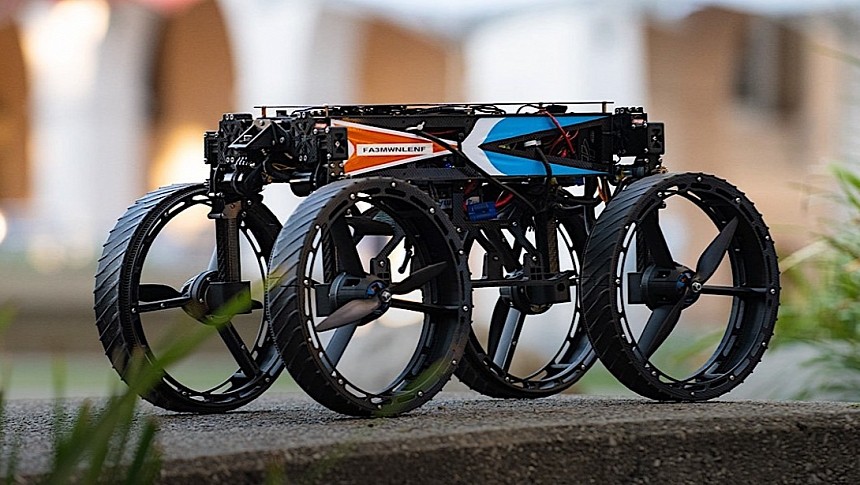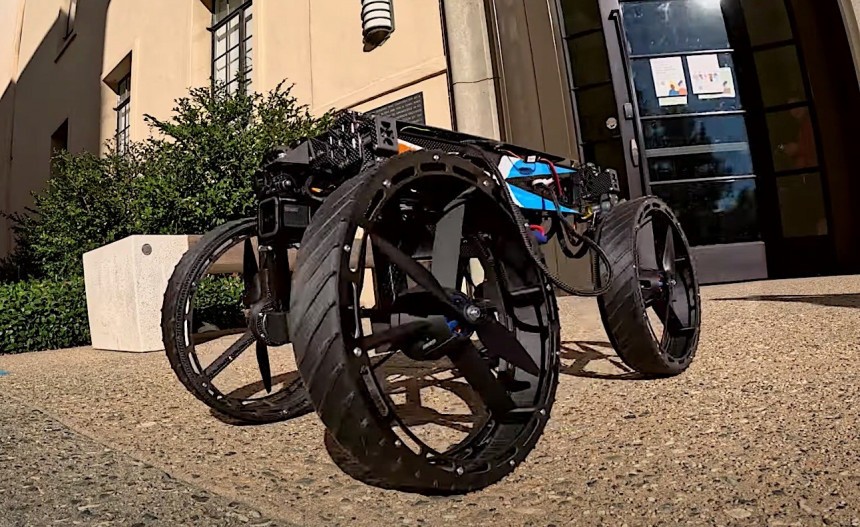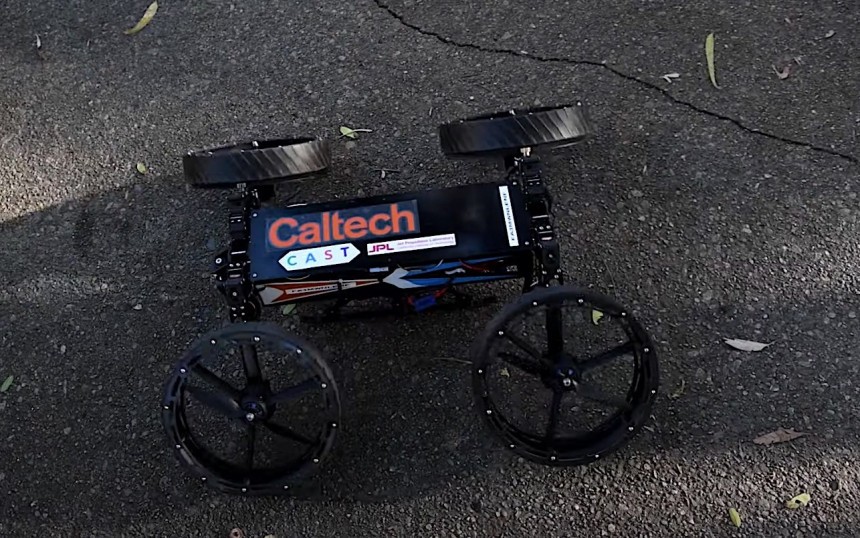On Saturday we brought you news of a new breed of modular robot called Mori3. Comprised of a number of bidimensional polygons that can come together to form three-dimensional tools and machines, it's a sight so impressive that, if successful, will probably forever change space exploration.
As revolutionary as the Mori idea is, it doesn't come even close to another wacky robot we uncovered this week. Nicknamed Transformer, it is not only capable of shapeshifting, but can fly, roll, or walk, depending on the need of the moment.
The real-life Transformer robot is an idea that popped into the heads of researchers from the Caltech Center for Autonomous Systems and Technologies (CAST). The team had as leads Mory Gharib, Professor of Aeronautics and Bioinspired Engineering, and Alireza Ramezani, assistant professor of electrical and computer engineering at Northeastern University. NASA and JPL had a hand in the thing as well.
Officially, the piece of tech is called M4. Yes, exactly like the carbine used by Western soldiers since the mid-1990s. In this case, though, M4 stands for Multi-Modal Mobility Morphobot.
Like many other great human ideas, the M4 was inspired by the animal world. We're told the people behind it looked at how the chukar partridge gamebird "use the flapping of their wings to give them leverage while running up steep inclines," and at how "sea lions use their flippers for different types of locomotion on sea and land."
Design-wise, the robot is nothing out of the ordinary. When you look at it in its default state, it looks like a small box propped on four large wheels. But that's a trick, as the machine can reconfigure its appendages to "achieve eight distinct types of motion."
The idea behind the whole thing was to create a platform capable of adapting the means of locomotion to the terrain that needs to be navigated, or the mission that is to be performed.
The morphobot can essentially repurpose its wheels to act as legs, and even thrusters, whichever it deems most effective to get on with its dealings.
Because it is powered by artificial intelligence (of undisclosed nature), the robot can decide on its own which means of locomotion is most effective, or whether a combination of them is needed.
Say that at one point, as it rolls on the surface of an alien planet, the robot comes across a terrain feature it can't navigate on wheels. Since it doesn't know what's behind the feature, it can choose to lift itself on two wheels to gain height and a better perspective. It does this by folding up two of the wheels and engaging their propellors to provide balance.
Should the terrain behind the obstacle prove too tough to handle, the robot can turn all of its four wheels into lifting gear by simply folding all of them up and spinning the propellors.
Both these means of locomotion are clearly demonstrated in the video below, which shows the M4 rolling and flying on the Caltech campus.
But there are other things it can do, yet not clearly demonstrated. Should the terrain require a more cautious approach, the robot could technically walk at a slower speed, moving its wheels forward one at a time, without rolling them.
In two-wheel mode, the M4 could roll up steep slopes, and if that's the best choice for forward motion, it could also tumble, without hurting itself. The tricks the robot can do have not been detailed.
To some extent, perhaps even carmakers could find a use for it, as the transition from wheeled movement to flight seems like the magic solution the industry was waiting for to make flying cars, true flying cars, a reality.
As for possible applications on Earth, the list is literally endless, and includes anything from disaster relief to cargo delivery.
But, as usual when it comes to revolutionary advancements in technology, people have to start somewhere. So who knows what extraordinary tech the machine described above will inspire?
The real-life Transformer robot is an idea that popped into the heads of researchers from the Caltech Center for Autonomous Systems and Technologies (CAST). The team had as leads Mory Gharib, Professor of Aeronautics and Bioinspired Engineering, and Alireza Ramezani, assistant professor of electrical and computer engineering at Northeastern University. NASA and JPL had a hand in the thing as well.
Officially, the piece of tech is called M4. Yes, exactly like the carbine used by Western soldiers since the mid-1990s. In this case, though, M4 stands for Multi-Modal Mobility Morphobot.
Like many other great human ideas, the M4 was inspired by the animal world. We're told the people behind it looked at how the chukar partridge gamebird "use the flapping of their wings to give them leverage while running up steep inclines," and at how "sea lions use their flippers for different types of locomotion on sea and land."
Design-wise, the robot is nothing out of the ordinary. When you look at it in its default state, it looks like a small box propped on four large wheels. But that's a trick, as the machine can reconfigure its appendages to "achieve eight distinct types of motion."
The morphobot can essentially repurpose its wheels to act as legs, and even thrusters, whichever it deems most effective to get on with its dealings.
Because it is powered by artificial intelligence (of undisclosed nature), the robot can decide on its own which means of locomotion is most effective, or whether a combination of them is needed.
What can the M4 morphobot do?
First and foremost, as you can see in the video attached below, it can roll on four wheels. There's nothing extraordinary about this, as that's what objects have been doing ever since the wheel was invented. The wheels themselves though are special, as they have propellors for spokes.Say that at one point, as it rolls on the surface of an alien planet, the robot comes across a terrain feature it can't navigate on wheels. Since it doesn't know what's behind the feature, it can choose to lift itself on two wheels to gain height and a better perspective. It does this by folding up two of the wheels and engaging their propellors to provide balance.
Should the terrain behind the obstacle prove too tough to handle, the robot can turn all of its four wheels into lifting gear by simply folding all of them up and spinning the propellors.
But there are other things it can do, yet not clearly demonstrated. Should the terrain require a more cautious approach, the robot could technically walk at a slower speed, moving its wheels forward one at a time, without rolling them.
In two-wheel mode, the M4 could roll up steep slopes, and if that's the best choice for forward motion, it could also tumble, without hurting itself. The tricks the robot can do have not been detailed.
What can the morphobot be used for?
The simple answer to that is: pretty much anything. Because of the way it can do things, it will probably be of particular interest to the aerospace industry, which could see it as an inspiration for the next generation of rovers.To some extent, perhaps even carmakers could find a use for it, as the transition from wheeled movement to flight seems like the magic solution the industry was waiting for to make flying cars, true flying cars, a reality.
As for possible applications on Earth, the list is literally endless, and includes anything from disaster relief to cargo delivery.
How close to real-life applications is the M4 morphobot?
Not close, really. Although a paper on the subject was published in Nature last week, we are not given any indication that the idea is anywhere close to being used in the real world for a tangible purpose. Just like the Mori3, for that matter.But, as usual when it comes to revolutionary advancements in technology, people have to start somewhere. So who knows what extraordinary tech the machine described above will inspire?











